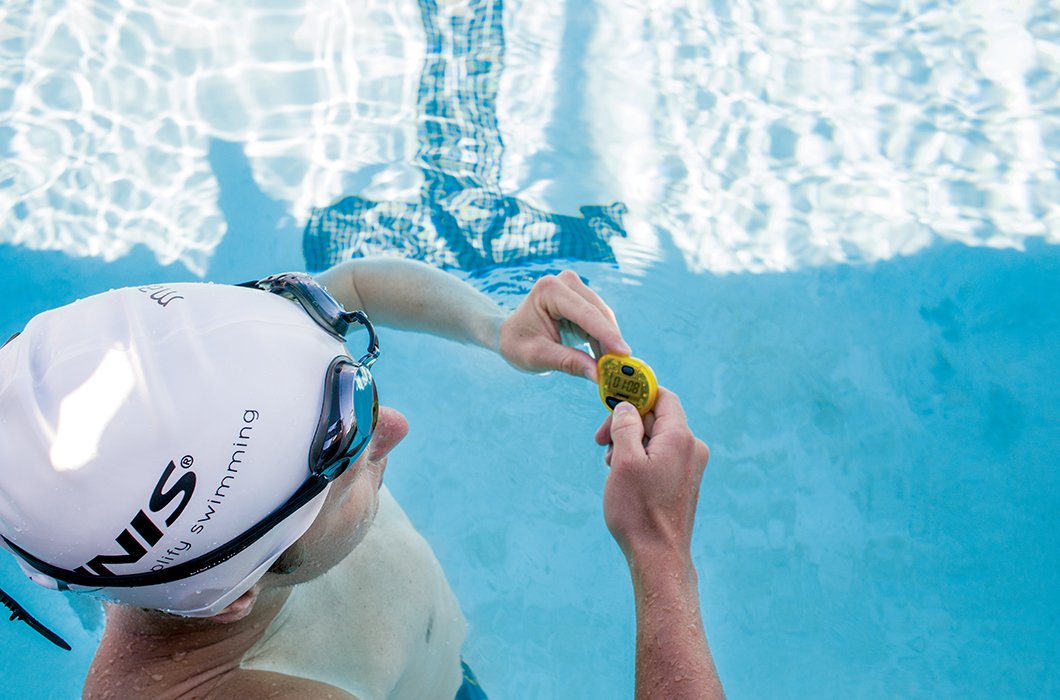Terry Laughlin, Total Immersion
October 12, 2018
Last week’s post on “Endurance Skills” illustrated a practice set that included the use of the “Tempo Trainer” pacing device– a waterproof electronic “metronome” worn while swimming– in one of the sets. Terry Laughlin was an enthusiastic proponent of the Tempo Trainer, and it was one of the few “pool tools” that he recommended and used regularly in his own practice and training. Describing the Tempo Trainer’s effectiveness, Terry wrote:
“You learn to improve your rhythm, pace, and speed without sacrificing efficiency. The TT focuses you. The audible beep keeps your attention on each stroke you take and helps banish distraction. The TT improves your rhythm. Consistent rhythm is an essential skill of successful swimming. It’s also the quality that harmonizes the various elements of the stroke. The TT teaches unerring pace. Sense of pace is usually thought of as a trait you just have or acquire through endless repetition. The TT is a fast, and almost effortless, way to learn this critical skill. Just keep strokes per length (SPL) consistent and synchronized to the beep as you swim farther. If SPL and Tempo remain steady, so does pace.” (For a full description of this product or to purchase your own Tempo Trainer, click HERE .)
Below is a great example of a short practice set (posted by Terry on the T.I. forum in January 2011) that shows how to increase stroke length through precise adjustments to one’s stroke tempo, with the use of the Tempo Trainer and counting strokes per length (SPL).

Practice Set To Improve Stroke Length
Try this exercise with Tempo Trainer. You may need to experiment a bit to find the tempo range that suits you best.
Swim 10 x 25. Reset TT by 0.1 sec. each time. On 1st 5, reset TT slower each time. On next 5, reset TT faster each time.
Count strokes on each 25 and compare.
Here’s an example:
1.6
1.7
1.8
1.9
2.0
1.9
1.8
1.7
1.6
1.5
How many strokes did you start with?
How many did you subtract as tempo slowed?
Was your SPL (strokes per length) the same or fewer when you returned to starting point (9th 25)?
Was it still the same or fewer when you finished? (0.1 faster than starting)?
Allow 3 beeps on all pushoffs to keep that part consistent.
I encourage you to do this initially at a range that takes you to a slower tempo than you have ever swum at, such as the example given. For Freestyle, I’m not sure there’s a benefit to swimming above 2.0, but my experience going as high as 2.0 was eye-opening. Until I did the set as outlined above, I’d never used a tempo slower than 1.5. I found that from 1.8 to 2.0 any balance flaws I had became exposed. And with the tempo as slow as it was, I could sense where and why they occurred.
You can also do this with 50s. Allow 4 extra beeps on turns. Count total strokes for 50.
I plan to repeat this once or twice a week. I’ll do it either as a start-of-practice tuneup, or at the end of effortful practices to re-tune my stroke and send me to the showers feeling great.
I’ll do it both with 25s and 50s, and will probably start at a slower range, and use incrementally faster ranges over time.
I also plan to do this with Backstroke.
If you do the set, in any form, please share your results here. And if you find they improve over time, please share that too.
Eventually I want to be doing this set starting @ 1.0 and finishing @ 0.9. I’ll let you know how it goes.
View Original Article
Recent Articles
Dylan Carter
Chelsea Hodges
Lorenzo Zazzeri

Introducing the Stability Snorkel Jr
Share on Social Media


